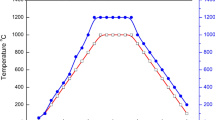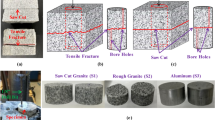Abstract
Latent heat thermal energy storage by using phase change materials (PCMs) to store and release thermal energy is considered to be an efficient, environmental and promising thermal energy storage method for energy conservation. The advantages of PCMs on thermal energy storage works are in terms of keeping constant temperature during the phase change process. It is especially important for researching and developing phase-change materials (PCMs) with low operation cost, simple process, stable performance and favorable durability. In this study, paraffin/SiO2 composite phase-change materials (CPCMs) were prepared with cheap and environmental paraffin as the core material and with industrial water glass for the preparation of the nano-SiO2 as the shell material and characterized. From the technological parameters of CPCMs, select 8 items and analyze data by comprehensive assessment based on the efficacy coefficient method. It was indicated seepage circle, coating rate, phase-change enthalpy, mass loss ratio, density, thermal conductivity and temperature regulation performance are positive response. When the paraffin/water ratio was 1:4, pH is 4.5, the temperature is 35°Cand the paraffin/hydrated silica ratio is 2:1, the system efficacy coefficient of the optimum parameters is 0.8162and it’s the most significant. The method is effectively used to analyze the optimum value and could be significant in material optimization for next experiments.






Similar content being viewed by others
References
Hassan Nazir, Mariah Batool, Francisco J, Bolivar Osorio, et al. (2019) Recent developments in phase change materials for energy storage applications: A review [J]. International Journal of Heat and Mass Transfer. (129) 2:491–523
Jingwen Weng, Xiaoqing Yang, Guoqing Zhang, et al. (2019) Optimization of the detailed factors in a phase-change-material module for battery thermal management [J]. International Journal of Heat and Mass Transfer. (138) 8:126–134
Fauzi HD, Metselaar HSC, Mahlia TMI et al (2015) Thermal characteristic reliability of fatty acid binary mixtures as phase change materials (PCMs) for thermal energy storage applications[J]. Appl Therm Eng 80(5):127–131
Wang Y, Zhang Y, Xia T et al (2014) Effects of fabricated technology on particle size distribution and thermal properties of stearic-Eicosanoic acid/Polymethylmethacrylate Nanocapsules[J]. Sol Energ Mater Sol C 120(1):481–490
Sarı A, Alkan C, Altıntaş A (2014) Preparation, Characterization and Latent Heat Thermal Energy Storage Properties of Micro-Nanoencapsulated Fatty Acids by Polystyrene Shell[J]. Appl. Therm. Eng. 73(1): 1 160–1 168
Silakhori M, Metselaar HSC, Mahlia TMI et al (2014) Palmitic acid/Polypyrrole composites as form-stable phase change materials forThermal energy storage[J]. Energ Convers Manage 80:491–497
Li HQ, Chen HS, Li XY et al (2014) Development of thermal energy storage composites and prevention of PCM leakage[J]. Appl Energy 135:225–233
Fang C, Wolcott M (2015) Polyethylene/paraffin binary composites for phase change material energy storage in building: a morphology, thermal properties, and paraffin leakage study[J]. Sol Energy Mater Sol Cells 137:79–85
Zhang ZG, Zhang N, Peng J et al (2012) Preparation and thermal energy storage properties of paraffin/expanded graphite composite phase change material[J]. Appl Energ 91(1):426–431
Zhang XX, Tao XM, Yick KL et al (2005) Expansion space and thermal stability o microencapsulated n-octadecane. J Appl Polym Sci 97:390–396
Liu X, Wang SJ, Liu HY (2006) Research of paraffin encapsulated in MUF resins[J]. Polymer materials science and engineering 22(2):235–238
Wang Y, Shi H, Xia TD et al (2012) Fabrication and performances of microencapsulated paraffin composites with polymethylmethacrylate shell based on ultraviolet irradiation-initiated[J]. Mater Chem Phys 135:181–187
Liu L, Wang L, Wang Y W, et al. (2014) Test and analysis on the thermal properties of microencapsulated phase change material suspension using propanol /water solution as base fluid[J]. Journal of Functional Materials. (45)1:1109–1113
Liang J S, Liang G C, Liang X H, et al. Test method for stability of phase-change composite materials: 1462876[P].2003/12/24
Meng D, Wang L J (2017) Preparation and characterization of CA-MA Eutectic/Silicon Dioxide Nanoscale Composite Phase Change Material from Water Glass via Sol-Gel Method [J]. Journal of Wuhan University of technology-Materials Science Edition. (5)32:1048–1056
Min Li, Boyuan Mu (2019) Effect of different dimensional carbon materials on the properties and application of phase change materials: A review[J]. Applied Energy. (242)5: 695–715
Y.Qu, S.Wang, D.Zhou, et al. (2020) Experimental study on thermal conductivity of paraffin-based shape-stabilized phase change material with hybrid carbon nano-additives [J]. Renewable Energy. (146)2: 2637–2645
Li LP, Wang G, Guo CG (2016) Influence of intumescent flame retardant on thermal and flame retardancy of eutectic mixed paraffin/polypropylene form-stable phase change materials. Appl Energy 162:428–434
Shi T, Li S S, Zhang H, et al. (2017) Preparation of palygorskite-based phase change composites for thermal energy storage and their applications in trombe walls[J]. Journal of Wuhan University of Technology-Mater. Sci. Ed.,11:1306–1317
Xu BW, Li ZJ (2013) Paraffin/diatomite composite phase change material incorporated cement-based composite for thermal energy storage[J]. Appl Energy 105:229–237
Xu BW, Li ZJ (2014) Paraffin/diatomite/Multi-Wall carbon nanotubes composite phase change material tailor-made for thermal energy storage cement-based composites[J]. Energy 72:371–380
Xu BW, Ma HY, Lu ZY et al (2015) Paraffin/expanded vermiculite composite phase change material as aggregate for developing lightweight thermal energy storage cement-based composites[J]. Appl Energy 160:358–367
Sarra Drissi, Tung-Chai Ling, Kim Hung Mo, et al. (2019) A review of microencapsulated and composite phase change materials: Alteration of strength and thermal properties of cement-based materials[J]. Renewable and Sustainable Energy Reviews. (110)8:467–484
Wang Z S, Hu M. Research on Preparation and Property of Phase Change Mortar[J]. Journal of basic science and engineering. 2016(24)2: 315–321
Li M, Wu ZS, Tan JM (2012) Properties of form-stable paraffin/silicon dioxide/expanded graphite phase change composites prepared by sol–gel method. Appl Energy 92:456–461
Luo RL, Wang SF, Wang TY et al (2015) Fabrication of paraffin@SiO2 shape-stabilized composite phase change material via chemical precipitation method for building energy conservation. Energy and Buildings 108:373–380
Babapoor A, Karimi G (2015) Thermal properties measurement and heat storage analysis of paraffinnanoparticles composites phase change material: comparison and optimization. Appl Therm Eng 90:945–951
Qin S K.Principle and application of comprehensive evaluation[M].Beijing: Electronics Industry Press, 2003:.12
Yang ZF, Qian JS (2004) Effect of constituent materials of concrete on technology and economy of concrete[J]. Chongqing Architecture 4:45–49
Wang ZS, Wang LJ (2011) Optimization of coarse aggregate content based on efficacy coefficient method. Journal of Wuhan University of Technology-Materials science edition 4:330–335
Zhao N, Wang ZS (2014) Optimization of rubber concrete mixtures based on efficacy coefficient-copula method[J]. Electron J Geotech Eng 19:16981–16990
Wang Z S, Zhao N. (2015) Optimization of Phase Change Material Content of energy storage mortar based on Efficacy Coefficient Method[J]. Mathematics in practice and theory. (45)8:128–135
Yang SQ, Gao WS (2006) Harmony coefficient and regional agricultural systems[J]. Agricultural Science in China 5(7):539–544
Zhan BJ, Shui ZH, Chen W et al (2009) Mix optimization of high performance concrete based on efficacy coefficient method[J]. Journal of Wuhan University of Technology 4:29–32
Shi G X, Wang Q C, Liu J Q. Application of coefficient of variation method in benefit evaluation of small watershed governance[J]. Bulletin of Soil and Water Conservation,2000(20)6:47
Acknowledgment
This work was supported by the Application technology research and development funds for the technology division of Deyang [number: 2015ZZ037].
Author information
Authors and Affiliations
Corresponding author
Additional information
Publisher’s note
Springer Nature remains neutral with regard to jurisdictional claims in published maps and institutional affiliations.
Rights and permissions
About this article
Cite this article
Hu, M., Guo, N. & Wang, L. Preparation and assessment of paraffin/SiO2composite phase change material based on the efficacy coefficient method. Heat Mass Transfer 56, 1921–1929 (2020). https://doi.org/10.1007/s00231-020-02830-z
Received:
Accepted:
Published:
Issue Date:
DOI: https://doi.org/10.1007/s00231-020-02830-z




